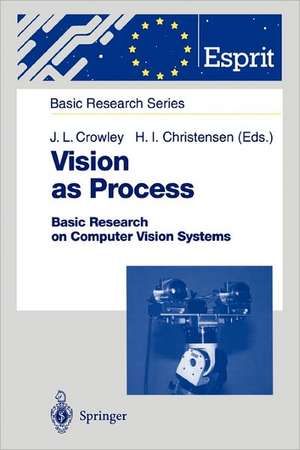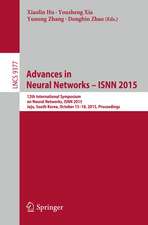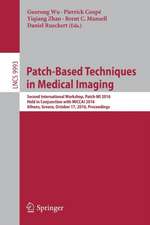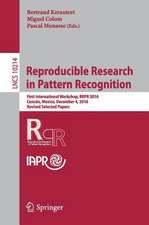Vision as Process: Basic Research on Computer Vision Systems: ESPRIT Basic Research Series
A. Chehikian Editat de James L. Crowley J.-O. Eklundh Editat de Henrik I. Christensen G. Granlund, E. Granum, J. Kittleren Limba Engleză Paperback – dec 2010
| Toate formatele și edițiile | Preț | Express |
|---|---|---|
| Paperback (1) | 994.26 lei 6-8 săpt. | |
| Springer Berlin, Heidelberg – dec 2010 | 994.26 lei 6-8 săpt. | |
| Hardback (1) | 1001.16 lei 6-8 săpt. | |
| Springer Berlin, Heidelberg – 19 dec 1994 | 1001.16 lei 6-8 săpt. |
Din seria ESPRIT Basic Research Series
- 20%
 Preț: 1001.16 lei
Preț: 1001.16 lei - 20%
 Preț: 329.58 lei
Preț: 329.58 lei - 20%
 Preț: 648.59 lei
Preț: 648.59 lei - 20%
 Preț: 643.63 lei
Preț: 643.63 lei - 20%
 Preț: 642.33 lei
Preț: 642.33 lei - 20%
 Preț: 330.10 lei
Preț: 330.10 lei - 20%
 Preț: 336.86 lei
Preț: 336.86 lei - 20%
 Preț: 664.59 lei
Preț: 664.59 lei - 20%
 Preț: 660.99 lei
Preț: 660.99 lei - 20%
 Preț: 333.54 lei
Preț: 333.54 lei - 20%
 Preț: 647.28 lei
Preț: 647.28 lei - 20%
 Preț: 337.85 lei
Preț: 337.85 lei - 15%
 Preț: 636.80 lei
Preț: 636.80 lei - 20%
 Preț: 339.34 lei
Preț: 339.34 lei - 20%
 Preț: 327.44 lei
Preț: 327.44 lei
Preț: 994.26 lei
Preț vechi: 1242.82 lei
-20% Nou
Puncte Express: 1491
Preț estimativ în valută:
190.31€ • 206.79$ • 159.97£
190.31€ • 206.79$ • 159.97£
Carte tipărită la comandă
Livrare economică 21 aprilie-05 mai
Preluare comenzi: 021 569.72.76
Specificații
ISBN-13: 9783642081972
ISBN-10: 3642081975
Pagini: 444
Ilustrații: VIII, 435 p.
Dimensiuni: 155 x 235 x 23 mm
Greutate: 0.62 kg
Ediția:Softcover reprint of hardcover 1st ed. 1995
Editura: Springer Berlin, Heidelberg
Colecția Springer
Seria ESPRIT Basic Research Series
Locul publicării:Berlin, Heidelberg, Germany
ISBN-10: 3642081975
Pagini: 444
Ilustrații: VIII, 435 p.
Dimensiuni: 155 x 235 x 23 mm
Greutate: 0.62 kg
Ediția:Softcover reprint of hardcover 1st ed. 1995
Editura: Springer Berlin, Heidelberg
Colecția Springer
Seria ESPRIT Basic Research Series
Locul publicării:Berlin, Heidelberg, Germany
Public țintă
ResearchCuprins
I Integration and Control of Perception.- 1. System Integration and Control.- 2. The SAVA Skeleton System.- 3. KTH Software Integration in the VAP Project.- 4. A Vision Programmers Workbench.- II Image Processing and Description.- 5. Image Processing in the SAVA System.- 6. Building a Pyramid of Low-Pass Images.- 7. One-pass Polygonal Approximation of a Contour Image.- 8. Tracking and Description of Image Structures.- 9. Contextual Junction Finder.- III Advanced Image Processing.- 10. Introduction and Background.- 11. Phase-based Disparity Estimation.- 12. Low Level Focus of Attention Mechanisms.- 13. Tensor Based Spatio-temporal Signal Analysis.- 14. Line Extraction Using Tensors.- IV Active Gaze Control and 3D Scene Description.- 15. The KTH Head-Eye System.- 16. Hierarchical Control of a Binocular Camera Head.- 17. Active 3D Scene Description in Object Reference Frames.- 18. Geometric Description and Maintenance of 3D Objects in an Active Vision System.- V Active Scene Interpretation.- 19. Control of Perception.- 20. Control of Scene Interpretation.- 21. Recognition of Polyhedral Objects Using Triangle-pair Features.- 22. Recognition of 3D Cylinders in 2D Images by Top-Down Model Imposition.- 23. Camera Control for Establishing the Current and Next-Look Direction in an Active Vision Object Recognition System.- VI Lessons Learned.





























